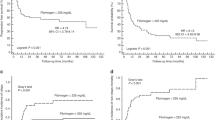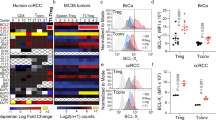Abstract
PATIENTS with advanced cancer and lymphoid malignancies often show impaired cellular and humoral immune responses, partly caused by serum factors inhibiting lymphocyte reactivity1–3, which, although not fully defined, are considered to be low molecular weight (poly)peptides. Another frequent finding in malignant diseases is the appearance of circulating fibrin(ogen) degradation products (FDPs)4,5. Besides the commonly investigated breakdown products X, Y, D and E, plasmin liberates several small peptides from human fibrinogen designated “micromolecular FDPs”6. These are dialysable, thermostable, have molecular weights between 15,000 and 500 (ref. 6) and have distinct physiological properties7–10. Since both the degree of impairment of lymphocyte function and the frequency of FDP formation are related to the extent of neoplastic spread3,4, we investigated the influence of micromolecular FDPs on cellular and humoral immune responses. A striking immunosuppressive activity was found, possibly responsible for impaired immunoresponsiveness in cancer patients. Terminal FDPs were obtained by prolonged digestion of human fibrinogen (Forschungsfibrinogen Kabi) with human plasmin (Forschungsplasmin Kabi) in aqueous solution, pH 7.4, and dialysed against distilled water at 4 °C for 24 h. The dialysate was concentrated by evaporation in a vacuum, reconstituted in physiological saline, sterilised by filtration and added to lymphocyte cultures using a microculture system11. As Fig. 1 shows, micro-molecular FDPs caused a dose-dependent suppression of PHA-induced lymphocyte transformation, which was 98% at 1.1 mg m1−1. These concentrations did not affect cell viability as measured by Trypan blue exclusion. Plasmin dialysates alone, prepared in identical conditions, inhibited neither of the systems tested: separation of fibrinogen on Sephadex G-200 showed no evidence of pre-existing contaminants (Fig.4).
This is a preview of subscription content, access via your institution
Access options
Subscribe to this journal
Receive 51 print issues and online access
$199.00 per year
only $3.90 per issue
Buy this article
- Purchase on Springer Link
- Instant access to full article PDF
Prices may be subject to local taxes which are calculated during checkout
Similar content being viewed by others
References
Scheurlen, P. G., Schneider, W., and Pappas, A., Lancet, ii, 1265 (1971).
Glasgow, A. H., et al., New Engl. J. Med., 291, 1263–1267 (1974).
Pappas, A., and Scheurlen, P. G., Verh. Dtsch. Ges. Inn. Med., 74, 1254–1256 (1968).
Carlsson, S., Acta Chir. scand., 139, 499–502 (1973).
Hedner, U., and Nilsson, M., Acta Med. scand., 189, 471–477 (1971).
Triantaphyllopoulos, E., Prep. Biochem., 3 (5), 451–472 (1973).
Stachurska, J., Latallo, Z., and Kopec, M., Thrombos. Diathes. Haemorrh., 23, 91–98 (1970).
Buluk, K., and Malofiejew, M., Br. J. Pharmac., 35, 79–89 (1969).
Niewiarowski, S., Ream, V. J., and Thomas, D. P., Thrombos. Diathes. Haemorrh. Suppl., 42, 49–59 (1971).
Larrieu, M. J., Scand. J. Haemat. Suppl., 13, 273–279 (1971).
Pees, H., and Pappas, A., Z. Immun.-Forsch., 150, 309–317 (1975).
Jerne, N. K., and Nordin, N. A. A., Science, 140, 405 (1963).
Ogston, D., and Dawson, A. A., Acta Haemat., 49, 89–95 (1973).
Scheurlen, P. G., Baake, M., Frey, N., Moers, P., and Sieberth, G., Dtsch. med. Wschr., 94, 17–23 (1969).
Ambrus, J. L., Baliah, T., Ambrus, C. M., Mink, I. B., and Murphy, G. P., N. Y. State J. Med., 74, 1396–1402 (1974).
Yu, V. Y. H., Waller, C. A., Maclennan, I. C. M., and Baum, J. D., Br. Med. J., 1, 428–432 (1975).
Riggio, R. R., Schwartz, G. H., Bull, F. G., Stenzel, K. H., and Rubin, A. L., Transplantation, 8, 689–694 (1969).
Dobbelstein, H., Klin. Wschr., 53, 461–466 (1975).
Lowry, O. H., Rosebrough, N. J., Farr, A. L., and Randall, R. J., J. biol. Chem., 193, 265–275 (1957).
Schwarze, G., and Scheurlen, P. G., Int. Archs Allerg., 46, 629–643 (1973).
Author information
Authors and Affiliations
Rights and permissions
About this article
Cite this article
GIRMANN, G., PEES, H., SCHWARZE, G. et al. Immunosuppression by micromolecular fibrinogen degradation products in cancer. Nature 259, 399–401 (1976). https://doi.org/10.1038/259399a0
Received:
Accepted:
Issue Date:
DOI: https://doi.org/10.1038/259399a0
Comments
By submitting a comment you agree to abide by our Terms and Community Guidelines. If you find something abusive or that does not comply with our terms or guidelines please flag it as inappropriate.



